|
|
Welcome to the AmericasWonderlands.com Hiking Long's Peak page. Content below includes a combination of travel information, photos and stories about hiking Long's Peak in Rocky Mountain National Park, Colorado. The page is intended to give potential Long's Peak hikers an idea of what it will be like to climb Long's Peak and provide enough information to begin planning a trip.
Site content is divided into the following sections as described by their respective headings: Story, Logistics & Planning, Camping & Lodging, Advisories & Suggestions and Books & Maps.
Story
1st Ascent (August 1999)
Craig, Randy and I drove from the Denver airport to the Olive Ridge Campground just outside of Rocky Mountain National Park. We were planning to spend Friday night camping before hiking Long's Peak on Saturday.
We decided on the Long's Peak trail after reading selections from a book with descriptions of various hiking trails. The book described the Long's Peak trail in addition to some of the other hikes in the area. The description was favorable and one of my relatives had talked about the spectacular views from the Keyhole (point along the trail). The climb sounded difficult but worth the effort. We talked it over and decided to go for it.
The trail description mentioned the possibility of snow (even in summer) so I called the Rocky Mountain National Park backcountry office while waiting in the airport to see if the Keyhole route was open to hikers without technical gear. Rangers indicated that there was still snow at higher elevations and that ice axes and cramp-ons were required to hike beyond the Keyhole. I talked with Craig and Randy and we decided to go ahead and hike to the Keyhole.
It was near dusk on Friday evening, after a stop for pizza, when we pulled into the Olive Ridge campground. Olive Ridge is the only campground within a reasonable distance from the trail and it was full. Randy talked with a couple of campers who were kind enough to let us park the car in their spot while we hiked back into the woods with our gear to spend the night. We found a spot, set up camp and enjoyed the night under the stars.
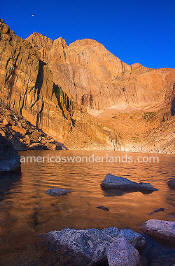 The trail
description urged hikers to start in the early hours of the morning (~3am) if
attempting to hike to the summit and return in one day. Starting early would allow
hikers to summit and come down before any thunderstorms moved into the area. We
half-heartedly tried to get up early and had agreed there was no need to start
at 3am if we weren't going to hike past the Keyhole. We left the ranger
station (elev. 9404) at 6am. Signs at the trailhead indicated the presence
of snow on the route so we didn't feel too bad about starting late.
The trail
description urged hikers to start in the early hours of the morning (~3am) if
attempting to hike to the summit and return in one day. Starting early would allow
hikers to summit and come down before any thunderstorms moved into the area. We
half-heartedly tried to get up early and had agreed there was no need to start
at 3am if we weren't going to hike past the Keyhole. We left the ranger
station (elev. 9404) at 6am. Signs at the trailhead indicated the presence
of snow on the route so we didn't feel too bad about starting late.
We were planning to hike to the Keyhole with a stop in Boulder Field for lunch. I carried one of those large cans of beef stew in a book bag type backpack along with a probably 3 liters of water. Craig and Randy carried the stove, fuel, etc.
We were finally ready to go and began the hike up the mountain. The Long's Peak trail is 16 miles round trip to the summit with an elevation gain of almost 5000 ft (9702 ft round trip). The altitude makes it more difficult to breathe so it wasn't long before we were huffing and puffing. The hike is difficult by any measure. Randy, Craig and I didn't have a lot of experience with this type of hiking so didn't know what to expect. We were all in good shape and thought it wouldn't be any problem.
The hike proceeded through the woods for a while past a waterfall. We took frequent breaks. I usually like to combine breaks with photo opportunities; but needed to stop more often on this hike.
We were about a mile or two up the trail when this guy in shorts, trail running shoes and a Camelback runs by us. Another guy in running tights flies by a short time later. These guys were in great shape (16 miles round trip, 9702+ feet total elevation change between 9404-14255 ft).
We continued hiking to a popular break area near the junction with the Chasm Lake trail. There's an outhouse and great view of Long's Peak. Hikers with binoculars can sometimes see people on the summit. We started hiking again and met one of the runners on his way down. He had been to the summit which meant the route was clear of snow and could be climbed without technical gear.
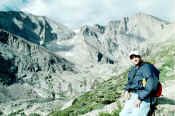 Long's Peak with Peacock Pool in the background
Long's Peak with Peacock Pool in the background
We arrived in the barren moonscape of Boulder Field about 11am. There are no trees up here. It's a vast, barren field of rocks. As the slope rises to the Keyhole (visible in the distance), the rocks get as big as trucks and you have to scramble up and over them to climb to the keyhole. Craig wasn't feeling very well and neither was Randy although not as bad. We sat and talked for a minute and I decided to go ahead and try for the summit.
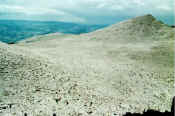
 View of Boulder Field from the Keyhole and the Keyhold from Boulder Field
View of Boulder Field from the Keyhole and the Keyhold from Boulder Field
It's approximately 1/2 mile from Boulder Field to the Keyhole. I made the last few scrambles and caught my first glimpse through the Keyhole - wow! The view was amazing and quite different than anything yet seen on the hike. The drop below was unfathomable and the range stretched out across the valley for 180 degrees.

Long's Peak Hike, Keyhole Route. 180 degree panoramic view from beyond the Keyhole.
Now on the other side of the Keyhole, I noticed some storm clouds moving across the distant range. The clouds were still far away; but I would have to get moving to make the summit before it started raining. A horizontal traverse connects the Keyhole with The Trough. The trail becomes somewhat treacherous along this traverse. An iron bar was driven into the rock in one area to assist hikers through a cut in the rock. There are steep, long drops all along the trail from the Keyhole to the Summit and people have been seriously injured and killed.
I was soon looking up from the bottom of the Trough. It's a tough climb through loose rock (scree) to the top. I was getting really tired and running low on water. My blue jeans and pullover windbreaker were becoming very uncomfortable. I passed one person resting on a rock and she offered me an ibuprofen. It must have been obvious that I was tired and had a headache.
I made it to the top of the Trough. I turned around to see the clouds rolling inbound across the distant range. It was an electrical storm with occasional flashes of lightning. People were coming down from the top as I pondered whether or not to continue. "How much farther is it?" I'd ask.
"About 45 minutes to the top." seemed to be the consensus.
If it was 45 minutes to the top, 45 minutes back to the Trough and another 45 minutes to the relative safety on the other side of the Keyhole, the rain would have to hold off for 2 1/2 hours. I wasn't sure when it would arrive; but it was definitely coming. Could I make the summit and get back to the Keyhole before the rain started? I didn't want to be on this side of the Keyhole in the rain. I suspected the rocks would get slick and lightning would be a hazard (especially on top). I thought about it for a while and asked a few people what they thought.
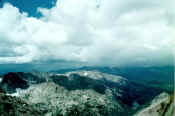
 Inbound storm clouds as seen from the Trough
Inbound storm clouds as seen from the Trough
People continued descending from the summit over the lip of the Trough. I asked one guy for his opinion and he looked at me with empathy and said, "I wouldn't". The guy appeared to be experienced and I trusted his judgment. He seemed to know what I was thinking.
I turned around and headed down.
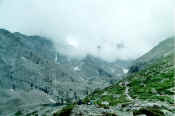 The peak now obscured by clouds on the way down. Chasm lake (or Peacock
Pool) in foreground.
The peak now obscured by clouds on the way down. Chasm lake (or Peacock
Pool) in foreground.
I plodded past the ranger station at the trailhead several hours later. The car was gone so I assumed Craig and Randy went off to get food or something. They came back a short time later and told me that word had reached the bottom of a death on the mountain. Somebody was struck by lightning that very day.
They were glad to see me; but still let me have it... I'd taken the can of stew with me when I left the Boulder Field so they didn't get to eat lunch! ;-)
I was exhausted. We went back to Olive Ridge where Craig and Randy had found a camp site. We set up camp and cooked dinner. The next day we drove into another area of the park looking for a short, relaxing hike.
We asked the young lady ranger about a hike to a waterfall described in the book.
"Well, there's a hike to this area; but it's a fairly long trail." she said.
"No, not that one." we agreed.
"There's this other hike to a fall; but I'm not sure if there's water this time of year." she continued.
"Ok, we'll pass on that one." we replied.
"There's a hike up a trail not far from here; but it's really short so you guys probably wouldn't want to do that one."
"Yes!! That's the one! The short one!" we said in unison. We spent the rest of the morning on the leisurely hike by the river and flew out later that day.
The first trip up the mountain taught me a few things: don't wear jeans (they get wet with sweat and can make you cold); wear layers that zip down the front so you can vent, wear gloves when scrambling, take a lot of water and pack light (or stay overnight). Lastly, that I'd made the right decision to come down and wanted to go back and try again.
I was surprised to meet others like me who had tried to climb Long's Peak but turned back before the summit. It wasn't long before I was planning a return trip with Craig, Randy and 4 others (Brett, Kevin, Brian and Reg).
We decided to try camping in the Boulder Field. There were a couple of driving reasons for this including: staying the night in Boulder Field would divide the hike into two smaller hikes. It would also allow for an additional day to acclimate to the altitude. The downside would be that we'd have to pack our stuff up to Boulder Field (one way: ~6 miles, elev. 12760 ft, a gain from the trailhead of 3356 ft).
The group agreed that we'd pack up to Boulder Field and spend the night. I reserved camp sites for the last week of August, 2000 along with a site in Olive Ridge campground to stay the night before. Note: Boulder Field camp spots go fast and can be reserved starting in MM/DD (call backcountry office number below to inquire).
We all met in the Olive Ridge campground on Friday night. We stayed overnight in the campground and began our hike up to Boulder Field mid-morning on Saturday after picking up the permits at the ranger station.
The hike was the same as before with one notable exception. We met a group of backpackers who were coming down.
 Reg, Brett, Randy, Kevin P., and Brian
Reg, Brett, Randy, Kevin P., and Brian
"You staying overnight in Boulder Field." they asked.
"Yes!" we said enthusiastically.
"Oh.... woe! Have fun!" they said in such a way that left us wondering... 'what have we gotten into?'
The trail levels off as it enters Boulder Field. We were just making our way into the camping area around 4pm when it started sleeting rain. We hurriedly began to set up the tents. Randy, Craig and I put together my freestanding tent and placed the tarp down in a flat, clear spot in the rocks. In one quick move, we shook the layer of sleet off the tarp and put the tent on top. Just as soon as the tent was in place, Craig and Randy crawled inside. "Get your wet shit out of the tent!" I complained. They handed me their gear and I covered it outside with my poncho. The tent is pretty large for 2 people; but small for 3 guys. Kevin P. had found a water source and was filtering water into a large collapsible container. It was cold and windy and still sleeting. The other guys (Brett, Brian and Reg) had finished setting up their tents and were also inside. My tent was set up outside the circular rock rings designed to protect the tents from the wind because there was only room for two tents inside the 2-3 foot high walls and my tent was the most resilient of the three. I spent some time tying it down to some rocks. I didn't stake it because the ground was rocky and I was cold.
I looked up to see a woman just arriving. She didn't have proper rain gear and was getting quite wet. She struggled to set her tent up in the wind and rain so I went over to offer help. She accepted and we set up her tent. She thanked me and looked at me with concern. "I was actually worried that I could die." she said. I was somewhat taken back. I hadn't really thought about the hazards of hiking until now. I really didn't know what to say.
I told her "Take off your wet clothes and get into your sleeping bag... I'll join you in a minute." ;-)
Just kidding... I pointed over to where we were staying and told her to come by if she didn't warm up.
| Randy's Comments on the night in
Boulder Field
Although Kevin was snug as a bug between Craig and Randy, they weren't feeling as well. The 3 man tent was pretty tight, and they were right against the sides of the tent that were flapping furiously in the over 35 mph wind gusts. On top of this, they both were suffering a touch of altitude sickness and were constantly going outside at night because they were nauseous. Around 4am some hikers came through with full packs. Their heavy packs seemed a bit odd since they were coming down that day. It was all clear that afternoon when we saw them on the peak. They had climbed the vertical cliff face up to the peak and the packs had all of their climbing gear in it. |
It was a miserable night. Some of the guys were nauseated and and I was getting cold after being outside for so long. I took off my outer layers and crawled into my sleeping bag between Randy and Craig. It was cozy; but probably a good thing in the cold. I drank a bunch of water and ate a quick snack (not sure if this is the right thing to do or not; but I didn't want to be dehydrated and thought eating would help). I warmed up after a while. We all just laid there being cold for a while until it stopped sleeting. I got up and started arranging things to cook dinner. We had two stoves but one of them didn't work so we had to cook with only one stove for 7 people. The wind was ripping through the area. It was strong enough to blow the metal lid off the pan so we put rocks on top. We didn't have a wind shield for the stove so stacked up gear around it. It took forever to cook dinner. Brett was cold and stayed in the tent - I found out later that the tent leaked and there was water in the bottom (yikes!). My tent is a convertible, 3-season tent (e.g. the windows zip completely closed) and we were cold. I can only imagine how cold Brett and Brian might have been.
We finished dinner and packed away the dirty dishes (watch for marmots).
The night was long and windy. It would be dead calm for a minute. Then, just as you got your hopes up, the tent would shake violently with the next gusty spell. We didn't sleep at all.
With all this time to think, I estimated the time that we would need to start hiking based on how long I thought it would take to summit, return to pack, hike down and get to the airport to catch our flights on Sunday.
I got up very reluctantly and started to make coffee and oatmeal. Others were even more reluctant and stayed inside. I was able to tempt Randy with an offer of breakfast. We ate while the others began to get around slowly. Hikers coming up from the bottom were passing through. A few hikers had even passed through while it was still dark using headlamps.
The wind was still blowing hard as clouds were hurled through the rocks surrounding Boulder Field. It was sunny but chilly and we were all still cold from the night before. My estimated departure time was nearing as we talked through tent walls. "Breakfast is done... 30 minutes until time to go." "Ok, almost time to leave." I wasn't sensing too much enthusiasm among the group.
Randy and I were ready to go and thus began the scramble up to the Keyhole from Boulder Field. There were a lot of clouds and I was really hoping it wasn't going to rain. I didn't want to get turned back again.
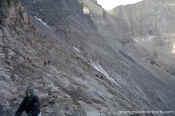 Randy on the traverse from the Keyhole to the Trough
Randy on the traverse from the Keyhole to the Trough
The view from the keyhole was every bit as amazing as before. The climb up The Trough was still a tough climb but went a lot smoother. From the top of the Trough to the Homestretch is a section called The Narrows. It's a narrow traverse with a steep drop. The Homestretch is a steep, straight section from the end of the traverse to the summit.
Top of the Trough and The Narrows
Randy and I proceeded up the Homestretch and walked onto the summit. There is something very gratifying about experiences like this. Spectacular views, accomplishing an eluded goal, physical challenge, etc.
Long's Peak Summit
Randy and I signed the sheet rolled up in a tube, ate a snack, marveled at the view and reveled in the experience for a while. Several technical climbers had just climbed the East Face. They were coiling up their ropes and lingering on the summit. In technical climbing circles, it's a big deal to climb the East Face of Long's Peak. We headed down after about 45 minutes.
As we descended the Homestretch, Craig, Kevin P., Brett and Brian were climbing up. We had a brief discussion as they asked if they should turn back so we wouldn't miss our flights. "You're almost there... keep going." They all made it. The only person in the group who didn't summit was Reg at his discretion. Reg elected to hike from Boulder Field to an area up on a rise in front of the peak to take pictures of the mountain and lake below.
Randy and I hiked back through the Keyhole and descended to Boulder Field. I could see spots of color from the Keyhole which were the tents in Boulder Field. I didn't see my tent. As we got closer, I made out what I thought was my tent; but it was in the wrong place. The wind had picked up my tent with all of our gear inside and tossed it like a tumbleweed across Boulder Field. Craig saw it happening and ran to catch it before it disappeared. He wedged the tent between some rocks and put some more rocks inside. I thought it was going to be ripped to shreds but it was patchable. The poles are now a little irregular but not too bad.
We packed up and got ready to go. The rest of the group arrived a bit later as they didn't linger as long on the top. We made good time on the way down and hurried to the airport. We skipped buying gas for the rental car and rushed to the ticket counter. We had just missed our flights by a matter of minutes. Luckily, there was a later flight with availability and they gave us seats on it. Randy flew from Chicago and was also able to get a later flight. We went and relaxed over dinner and drinks.
We did it!
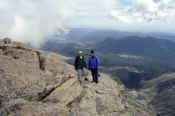 Randy and Kevin V. on the summit
Randy and Kevin V. on the summit
The nearest major airport is Denver International Airport. Rocky Mountain National Park is about a 2 hour drive from DIA.
Driving Directions from DIA to Allenspark, CO (Note: Olive Ridge campground just north of Allenspark. The Long's Peak trailhead is just off highway 7, north of Meeker Park, Olive Ridge and Allenspark) - see Overview Map.
Permits are required for overnight stays along the trail (e.g. camping in Boulder Field, Goblin's Forest, Battle Mountain (group site)). Call the Rocky Mountain Backcountry Office to inquire about permits at (970) 586-1242. There are 9 sites at Boulder Field (elev. 12760, 6 miles), 1 group site at Battle Mountain (elev. 11000, 2.8 miles) and 6 sites in Goblins Forest (elev 10120, 1.2 miles).
The trail is a strenuous 16 miles (round trip) with an elevation change from 9404 ft at the trailhead to 14255 ft at the summit (9702 ft round trip gain/loss).
There can be snow on the trail all year. Snow is least likely to be on the trail from mid-July to late August. Call the backcountry office at the number above to check on conditions and/or the best time of year to go.
The nearest campground is the Olive Ridge campground just south of the Long's Peak trailhead and just nort of Allenspark, CO along highway 7.
Directions to Olive Ridge
From Denver north on I-25 to US 36 west through Boulder to Lyons. From Lyons, take Colorado Highway 7 for 17 miles to campground (one mile north of the Allenspark fire station).
For more information about the park, please call (303) 747-2647
Reserve a campsite at ReserveUSA.com
Please note: be sure to review the cancellation policy. I am reluctantly including this link because I am not happy about my experience using this site. However, there isn't any other way to reserve a site in advance (that I am aware of). I made a last minute reservation for two nights of camping and cancelled it the next day due to changes in plans. The fees were incredibly outrageous under these circumstances and the lesson cost me over $30.
Other lodging options are available in nearby Estes Park (click here). If you don't find what you're looking for here, try this (google search).
Notes, Advisories & Suggestions
Lightning is a danger and should be taken seriously. Stay off high ground when conditions are such that lightning is possible.
Be prepared for cold weather. Take extra layers including rain pants and jacket, gloves and warm hat.
Take lots of water and snacks (incl a sports drink such as gatorade or powerade)
Don't wear cotton clothes (e.g. blue jeans, t-shirts). Wear clothes made of wicking materials such as Coolmax or DriFit.
There are steep drops along the trail. Don't try the hike if you're afraid of heights.
This is a serious mountain climb and there is a chance you could be seriously injured or killed... exercise caution. Respect the mountain and the weather.
There is some water on the hike down low; but not much up high. Carry as much water as you think you'll need.
Afternoon storms are common in the summer. Start your hike early (no later than 2-3am) so you'll be off the top of the mountain if it rains.
Hike takes 15-16 hours to complete. 7-8 hours up, 5-6 hours down.1
| 1 Frommer's Rocky Mountain National Park (Frommer's
Rocky Mountain National Park, 3rd Ed) by Don Laine, Barbara Laine The 2nd edition of this book is mentioned above in the story. It is a great overview of the park, well organized and provides information about hiking and other activities in the area. I like the Fommer's books because they break things up into sections that allow the reader to quickly get the information they want without having to read a lot. Buy Book. |
|
| This is a waterproof, 8 panel, double-sided map of the park. It's useful for getting around the area and includes many of the hiking trails and lakes. It is not a topographic map and should not be used for hiking; but can help you navigate to trailheads and to other areas without being as cumbersome as a topo map. Also doesn't get wrinkled and folded up backwards like a regular map so can be quickly reviewed without fumbling around. Buy Map | |
| Hiking Rocky Mountain National Park (9th
Edition) by Kent Dannen, Donna Dannen I don't have firsthand knowledge of this book; but have other Falcon Hiking Guides. If past experience holds true, they are primarily about the area's hiking trails and won't have as much information about the other activities. The Falcon Guides will have more information about the hiking trails in the park than the Fommer's book. It would likely be a good choice for those interested primarily in hiking and who are interested in hikes other than the Long's Peak trail. Buy Book |
|
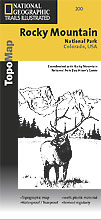 |
Rocky Mountain National Park topographic maps are available from amazon.com or Trails Illustrated. |
click the graphic to bring up all books from Amazon.com on hiking in Rocky Mountain National Park
Thank you for visiting.
Did you find this information helpful?
Disclaimer: information provided in good faith with no warranty or obligation attached. Be prepared for your adventures.
Your safety is your responsibility. Explore with respect.
Story and photos by K. Venator
America's Wonderlands
Copyright 2002 K. Venator